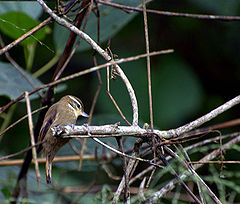Pełzaczniki
| Xenopinae | |||
| Bonaparte, 1854 | |||
 Przedstawiciel podrodziny – pełzacznik białowąsy (X. minutus) | |||
| Systematyka | |||
| Domena | eukarionty | ||
|---|---|---|---|
| Królestwo | zwierzęta | ||
| Typ | strunowce | ||
| Podtyp | kręgowce | ||
| Gromada | ptaki | ||
| Podgromada | Neornithes | ||
| Infragromada | ptaki neognatyczne | ||
| Rząd | |||
| Podrząd | tyrankowce | ||
| Rodzina | garncarzowate | ||
| Podrodzina | pełzaczniki | ||
| Typ nomenklatoryczny | |||
| Xenops genibarbis Illiger, 1811[a] | |||
| Synonimy | |||
| |||
| Rodzaje | |||
| | |||
| |||
| |||
Pełzaczniki[4] (Xenopinae) – monotypowa podrodzina ptaków z rodziny garncarzowatych (Furnariidae).
Zasięg występowania
Podrodzina obejmuje gatunki występujące w krainie neotropikalnej – południowym Meksyku, Ameryce Centralnej i Południowej[5].
Morfologia
Długość ciała 10–12 cm; masa ciała 9–15 g[6].
Systematyka
Etymologia
- Xenops: gr. ξενος xenos – nieznajomy, obcy; ωψ ops, ωπος opos – oblicze, twarz[7].
- Anecorhamphus: gr. ανεκας anekas – do góry, w górę (por. ανηκω anēkō – dochodzić, sięgać); ῥαμφος rhamphos – dziób[8]. Nowa nazwa dla Xenops.
Podział systematyczny
Podrodzina ta jest taksonem siostrzanym wobec Furnariinae lub Dendrocolaptidae[9][10][11][12][13]. Do podrodziny należy jeden rodzaj z gatunkami[4]:
- Xenops minutus – pełzacznik białowąsy
- Xenops rutilus – pełzacznik kreskowany
- Xenops tenuirostris – pełzacznik cienkodzioby
Uwagi
- ↑ Podgatunek X. minutus.
Przypisy
- ↑ G.J. Billberg: Synopsis Faunae Scandinaviae. T. 1. Cz. 2: Aves. Holmiae: Ex officina typogr. Caroli Deleen, 1828, s. tab. A. (łac.).
- ↑ Xenops, [w:] Integrated Taxonomic Information System [dostęp 2011-09-14] (ang.).
- ↑ J.K.W. Illiger: Prodromus systematis mammalium et avium: additis terminis zoographicis utriusque classis, eorumque versione germanica. Berolini: Sumptibus C. Salfeld, 1811, s. 213. (łac.).
- ↑ a b Systematyka i nazwy polskie za: P. Mielczarek & M. Kuziemko: Podrodzina: Xenopinae Bonaparte, 1854 – pełzaczniki (wersja: 2020-09-23). [w:] Kompletna lista ptaków świata [on-line]. Instytut Nauk o Środowisku Uniwersytetu Jagiellońskiego. [dostęp 2020-12-27].
- ↑ F. Gill, D. Donsker & P. Rasmussen (red.): Ovenbirds, woodcreepers. IOC World Bird List (v10.2). [dostęp 2020-12-27]. (ang.).
- ↑ V. Remsen: Family Furnariidae (Ovenbirds). W: J. del Hoyo, A. Elliott & D.A. Christie: Handbook of the Birds of the World. Cz. 8: Broadbills to Tapaculos. Barcelona: Lynx Edicions, 2003, s. 355–356. ISBN 84-87334-50-4. (ang.).
- ↑ Xenops, [w:] The Key to Scientific Names, J.A.J.A. Jobling (red.), [w:] Birds of the World, S.M. Billerman et al. (red.), Cornell Lab of Ornithology, Ithaca [dostęp 2022-02-04] (ang.).
- ↑ Anecorhamphus, [w:] The Key to Scientific Names, J.A.J.A. Jobling (red.), [w:] Birds of the World, S.M. Billerman et al. (red.), Cornell Lab of Ornithology, Ithaca [dostęp 2022-02-04] (ang.).
- ↑ J. Fjeldså, M. Irestedt & P.G.P. Ericson. Molecular data reveal some major adaptational shifts in the early evolution of the most diverse avian family, the Furnariidae. „Journal of Ornithology”. 146 (1), s. 1–13, 2005. DOI: 10.1007/s10336-004-0054-5. (ang.).
- ↑ J. Fjeldså, M. Irestedt, K.A. Jønsson, J.I. Ohlson & P.G.P. Ericson. Phylogeny of the ovenbird genus Upucerthia: a case of independent adaptations for terrestrial life. „Zoologica Scripta”. 36 (2), s. 133–141, 2007. DOI: 10.1111/j.1463-6409.2006.00270.x. (ang.).
- ↑ M. Irestedt, J. Fjeldså, L. Dalén & P.G.P. Ericson. Convergent evolution, habitat shifts and variable diversification rates in the ovenbird-woodcreeper family (Furnariidae). „BMC Evolutionary Biology”. 9, s. 268, 2009. DOI: 10.1186/1471-2148-9-268. (ang.).
- ↑ R.G. Moyle, R.T. Chesser, R.T. Brumfield, J.G. Tello, D.J. Marchese & J. Cracraft. Phylogeny and phylogenetic classification of the antbirds, ovenbirds, woodcreepers, and allies (Aves: Passeriformes: infraorder Furnariides). „Cladistic”. 25, s. 1–20, 2009. DOI: 10.1111/j.1096-0031.2009.00259.x. (ang.).
- ↑ E.P. Derryberry, S. Claramunt, G. Derryberry, R.T. Chesser, J. Cracraft, A. Aleixo, J. Pérez-Emán, J.V. Remsen Jr. & R.T. Brumfield. Lineage diversification and morphological evolution in a large-scale continental radiation: the Neotropical ovenbirds and woodcreepers (Aves: Furnariidae). „Evolution”. 65 (10), s. 2973–2986, 2011. DOI: 10.1111/j.1558-5646.2011.01374.x. (ang.).












